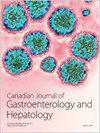新型粪便抗原生物发光酶免疫法检测幽门螺杆菌的临床评价
IF 2.7
4区 医学
Q2 Medicine
引用次数: 4
摘要
BLEIA™“EIKEN”幽门螺杆菌抗原(Helicobacter pylori antigen, B[EIA])是基于新开发的生物发光酶免疫分析法(BLEIA),该方法具有检测粪便中幽门螺杆菌(h.p ylori)抗原的高灵敏度。方法2019年佐贺县幽门螺杆菌筛查与治疗项目对141名学生进行粪便幽门螺杆菌抗原检测作为二次检测。对141名学生进行了B (EIA)和截至2019年在日本上市的体外诊断剂的比较测试。对商品人粪便标本中幽门螺杆菌ATCC43504标准株和幽门螺杆菌抗原的检测性能进行了研究。结果B (EIA)与Quick Chaser TMH的比较。幽门螺杆菌(Q [IC])的B (EIA)与Q (IC)的阳性和阴性符合率分别为100.0%(110/110)和71.0%(22/31)。将B (EIA)与截至2019年在日本上市的体外诊断试剂进行对比测试,结果显示,B (EIA)对“检测ATCC43504标准菌株的幽门螺杆菌抗原”和“检测商业人类粪便标本中的幽门螺杆菌抗原”比其他试剂盒最敏感。9例分离标本Q (IC)阴性,B (EIA)阳性。解离样品中B (EIA)的测定值为1.3 ~ 87.4,在其他粪便幽门螺杆菌抗原检测试剂盒可评价为阴性的临界值范围内,解离样品均为幽门螺杆菌抗原阳性病例,最后由于Q (IC)灵敏度不足,推定结果出现分歧的原因为假阴性。结论基于BLEIA方法(萤火虫荧光素酶发光)的B (EIA)比目前在日本销售的粪便抗原检测试剂盒更敏感,在诊断幽门螺杆菌感染方面非常有用,特别是在儿童等首选非侵入性检测的情况下。本文章由计算机程序翻译,如有差异,请以英文原文为准。
Clinical Evaluation of a Novel Stool Antigen Test Using Bioluminescent Enzyme Immunoassay for Detecting Helicobacter pylori
Background BLEIA ™ “EIKEN” Helicobacter pylori antigen (B[EIA]) is based on the bioluminescent enzyme immunoassay (BLEIA) method that was newly developed with high sensitivity in detecting Helicobacter pylori (H. pylori) antigen in feces. Methods In the project for H. pylori screening and treatment in Saga Prefecture in 2019, 141 students received the stool H. pylori antigen test as a secondary test. For 141 students, a comparative test was conducted between B (EIA) and extracorporeal diagnostic agents that were marketed in Japan as of 2019. The detection performance of H. pylori ATCC43504 standard strain and H. pylori antigen in commercial human fecal specimens were conducted. Results The comparison of B (EIA) with Quick Chaser TMH. pylori (Q [IC]) revealed positive and negative concordance ratios of B (EIA) to Q (IC) of 100.0% (110/110) and 71.0% (22/31), respectively. A comparative test was conducted between B (EIA) and extracorporeal diagnostic agents that were marketed in Japan as of 2019, and B (EIA) was most sensitive on “detecting H. pylori antigen of ATCC43504 standard strain” and “detecting H. pylori antigen in commercial human fecal specimens,” compared with other kits. Nine dissociated specimens that were negative for Q (IC) and positive for B (EIA) were confirmed. The measured value of B (EIA) in the dissociation samples were 1.3–87.4 cutoff index in the range that can be evaluated as negative by other fecal H. pylori antigen test kits, all the dissociation samples were H. pylori antigen-positive cases, and finally the cause of result divergence was presumed as false negative due to insufficient sensitivity of Q (IC). Conclusion B (EIA) that is based on the BLEIA method, which applies firefly luciferase luminescence, is more sensitive than stool antigen test kits that are currently marketed in Japan and is very useful in diagnosing H. pylori infection, especially in situations where noninvasive tests are preferred, such as in children.
求助全文
通过发布文献求助,成功后即可免费获取论文全文。
去求助
来源期刊

Canadian Journal of Gastroenterology and Hepatology
GASTROENTEROLOGY & HEPATOLOGY-
CiteScore
4.80
自引率
0.00%
发文量
0
审稿时长
37 weeks
期刊介绍:
Canadian Journal of Gastroenterology and Hepatology is a peer-reviewed, open access journal that publishes original research articles, review articles, and clinical studies in all areas of gastroenterology and liver disease - medicine and surgery.
The Canadian Journal of Gastroenterology and Hepatology is sponsored by the Canadian Association of Gastroenterology and the Canadian Association for the Study of the Liver.
 求助内容:
求助内容: 应助结果提醒方式:
应助结果提醒方式:


